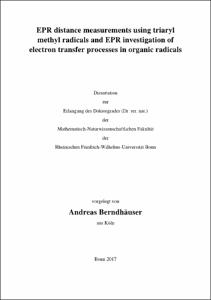Berndhäuser, Andreas: EPR distance measurements using triaryl methyl radicals and EPR investigation of electron transfer processes in organic radicals. - Bonn, 2018. - Dissertation, Rheinische Friedrich-Wilhelms-Universität Bonn.
Online-Ausgabe in bonndoc: https://nbn-resolving.org/urn:nbn:de:hbz:5n-50370
Online-Ausgabe in bonndoc: https://nbn-resolving.org/urn:nbn:de:hbz:5n-50370
@phdthesis{handle:20.500.11811/7543,
urn: https://nbn-resolving.org/urn:nbn:de:hbz:5n-50370,
author = {{Andreas Berndhäuser}},
title = {EPR distance measurements using triaryl methyl radicals and EPR investigation of electron transfer processes in organic radicals},
school = {Rheinische Friedrich-Wilhelms-Universität Bonn},
year = 2018,
month = apr,
note = {EPR is a valuable tool for the investigation of biological structures. Most EPR-based distance measurements rely on the site directed spin labeling of the investigated biomolecule, since most biomolecular structures do not contain unpaired electrons. Most measurements today are conducted in frozen buffer solutions. These conditions are not the natural environment of the biomolecules, and may affect their geometric structure. To overcome this drawback of the method, research efforts are made to develop protocols for distance measurements under biologically relevant conditions. In the pursuit of measurement conditions that are closer to biological conditions, new kinds of spin labels have emerged to overcome the limitations of the widely used nitroxide spin labels. One of the new kinds of labels is the triarylmethyl radicals (trityl). In this work, the optimization and comparison of four different pulsed EPRbased distance measurement techniques on two organic bistrityl model compounds is presented. Building on these results, the use of new trityl spin labels for trityl-iron(III) distance measurement on pseudomonas putida CYP101 P450 is demonstrated. The performance of the new spin labels is compared to the commercially available MTSSL nitroxide spin label and two other trityl spin labels known from literature. The use of one of these new spin labels for the first in cell distance measurement with a trityl radical is then demonstrated. This is also the first in cell distance measurement between a spin label and a native metal cofactor. The second part of this work deals with the investigation of electron transfer processes and radical intermediates of catalytic reactions. To that end, two setups were designed that combine electrochemistry and EPR. The first is a potentiostatic flat cell, the second a galvanostatic flow cell. Both systems were characterized using Wurster`s reagent and employed in the study of the electronic structure and electron self-exchange rate of radical salts of bis(2-pyridylmethyl)azine and bis(2-pyridylmethyl-5-tert-butyl)azine. Further, they were used to investigate the mechanisms of copper-catalyzed coupling reactions of tetrahydroisochinoline (THIQ) and the MacMillan organo-catalytic cycle. In all cases, chemical means for the generation of the radicals and additional methods like freeze quench were also employed. In the work presented here, strong experimental evidence is given for the existence of radical intermediates in both investigated catalytic cycles. This supports proposed radical mechanisms known from the literature.},
url = {https://hdl.handle.net/20.500.11811/7543}
}
urn: https://nbn-resolving.org/urn:nbn:de:hbz:5n-50370,
author = {{Andreas Berndhäuser}},
title = {EPR distance measurements using triaryl methyl radicals and EPR investigation of electron transfer processes in organic radicals},
school = {Rheinische Friedrich-Wilhelms-Universität Bonn},
year = 2018,
month = apr,
note = {EPR is a valuable tool for the investigation of biological structures. Most EPR-based distance measurements rely on the site directed spin labeling of the investigated biomolecule, since most biomolecular structures do not contain unpaired electrons. Most measurements today are conducted in frozen buffer solutions. These conditions are not the natural environment of the biomolecules, and may affect their geometric structure. To overcome this drawback of the method, research efforts are made to develop protocols for distance measurements under biologically relevant conditions. In the pursuit of measurement conditions that are closer to biological conditions, new kinds of spin labels have emerged to overcome the limitations of the widely used nitroxide spin labels. One of the new kinds of labels is the triarylmethyl radicals (trityl). In this work, the optimization and comparison of four different pulsed EPRbased distance measurement techniques on two organic bistrityl model compounds is presented. Building on these results, the use of new trityl spin labels for trityl-iron(III) distance measurement on pseudomonas putida CYP101 P450 is demonstrated. The performance of the new spin labels is compared to the commercially available MTSSL nitroxide spin label and two other trityl spin labels known from literature. The use of one of these new spin labels for the first in cell distance measurement with a trityl radical is then demonstrated. This is also the first in cell distance measurement between a spin label and a native metal cofactor. The second part of this work deals with the investigation of electron transfer processes and radical intermediates of catalytic reactions. To that end, two setups were designed that combine electrochemistry and EPR. The first is a potentiostatic flat cell, the second a galvanostatic flow cell. Both systems were characterized using Wurster`s reagent and employed in the study of the electronic structure and electron self-exchange rate of radical salts of bis(2-pyridylmethyl)azine and bis(2-pyridylmethyl-5-tert-butyl)azine. Further, they were used to investigate the mechanisms of copper-catalyzed coupling reactions of tetrahydroisochinoline (THIQ) and the MacMillan organo-catalytic cycle. In all cases, chemical means for the generation of the radicals and additional methods like freeze quench were also employed. In the work presented here, strong experimental evidence is given for the existence of radical intermediates in both investigated catalytic cycles. This supports proposed radical mechanisms known from the literature.},
url = {https://hdl.handle.net/20.500.11811/7543}
}






